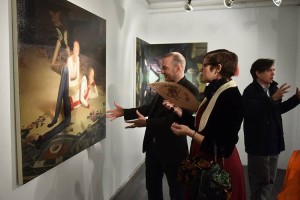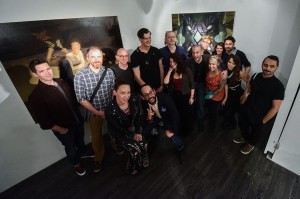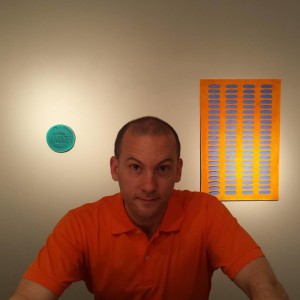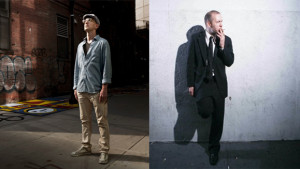Thanks so much to Artweek.com and Artjobs‘s Liza SKova for this interview from early August about new ideas, partnership and the unique purpose of The Lodge Gallery
By Liza Shashkova @ ARTWEEK, 2016
1. Jason, you are an NYC based curator, creative entrepreneur, director, producer and public speaker but you started out as an artist, am I correct ?
I did start out as an artist. When I was 13 years old I was growing up overseas in Taipei, Taiwan and I had an amazing teacher who showed me how to use oil paint. She encouraged me to think critically about art and seek to discover my own voice. From there I came to New York in 1991 to study painting at Pratt Institute. When I talk now about process, studio rituals or creative development, I still like to use the language of painting. I haven’t painted in quite a long time though. After I left Yancey Richardson Gallery in 2009, I was primarily writing and curating and from that came Republic Worldwide, followed by The Lodge Gallery after Keith and I finally met. I feel like it was all a fluid transition and each step along the way had informed the next.
” In a way, many of the questions and subjects I like to explore as a curator and a producer are the same subjects I found fascinating as a painter and a maker. “
2. What was the inspiration & motivation to open The Lodge Gallery with your partner, Keith Schweitzer ?
Keith and I worked together many times before we decided to move forward and open a new gallery together. When Keith and I met, he had just left No Longer Empty as a founding member and was the Director of Public Arts for F.A.B. in the Lower East Side. We teamed up to curate a few shows and served as the development directors for the last few iterations of the Fountain Art Fair in Miami and New York before we agreed to open The Lodge. We have always been interested in what the purpose and function of an art gallery should be and how we could make the most of the opportunity.
” We wanted to build an exhibition space with an alternative business model that could become a gathering point for our community to explore new ideas and engage in healthy debate. Our unusual hours accommodate all sorts of collectives and creative events that encourage and support that kind of discourse and experimentation. “
I think that if you look back at all the work we have done over the last four years, you will see repeated thematic patterns in our programing and that speaks for itself about the inspiration that guides our direction.
3. The Lodge Gallery began exhibiting and promoting mid-career artists in 2012. How has the gallery expanded in recent years and what is the next step ?
That’s true. Since 2012 we have been primarily promoting the work of mid-career representational artists who have already had a solo exhibition or two under their belts and price points based on existing sales histories. In addition to the average four solo exhibitions we produce each year,
” we also curate around five or six group exhibitions that allow us to open up opportunities to work with both younger emerging creatives and more established artists who are interested in a particular project or curatorial vision rather than long term obligations and contracted relationships. “
We have a loose stable of artists that we work with pretty regularly but our flexible approach has allowed us to develop projects that have attracted hundreds of the best working artists in New York and abroad. Each one of them is a different evolving relationship with respect to each artists needs and career goals.
There are a few interesting changes in our programing this year. Lately we have had a heavy focus on two person shows and have opened up at least three month long projects that bring in outside curators to the space. For example, in September we will be working with Michael David from Life on Mars Gallery in Brooklyn and in October, we are working with Dina Brodsky to install a fifty-person invitational group exhibition titled, Point of Origin.
4. Who is the most recent artist you exhibited and why did you choose them ?
Our current exhibition, Unintended Archeology, by Levan Mindiashvilli and Uta Bekaia is about screen memory. It is focused around the idea of remembering the past; even the most certain memories of your childhood, what you are really remembering is the last time you remembered remembering it. Now that sounds a bit confusing but it’s like playing a game of telephone with the memories of your life. The reality of your memory transforms each time you recall the thought. Levan and Uta are from The Republic of Georgia so many of the images are references to the post-Soviet era of Eastern Europe. Most of the work struggles through the effort to reconcile ideas like national identity and attempts to accurately recall transformation on both the personal and cultural levels. We’ve worked with Levan before. He did his first NY solo exhibition at The Lodge about two years ago. The decision to put this show together definitely comes out of our own curiosity about cultural identity and how to manage information inundation. There are also undertones of ideas about the relationship of the body to architecture and we have done a number of projects on that subject over the years. Our next show is titled, A Peculiar Nature, and features Sirikul Pattachote and Tawan Wattuya from Bangkok, Thailand. That opens August 3rd through September 4th.
5. Do galleries really need to have a physical space anymore, when business is mainly conducted at art fairs, phone or email ?
I suppose it all depends on how you define the purpose of a gallery. If a gallery is meant to be a purely commercial venture then I do not see much of a future in that for young gallerists or curators. It’s true that the business of selling art has transformed in ways no one ever saw coming 20 years ago. It’s funny to think about how the old gallery model has been surrounded by extremes of change on both sides. On one side you have the art fairs that satellite around the bigger art fairs with big money investors and art world insiders with all of the fruits of success and excess on display, on the other side, you have websites like Instagram and Facebook and other sites like Artnet and Artsy that empower the individual artist and turn painters and sculptors into creative entrepreneurs.
” It’s fair to say that an ambitious creative entrepreneur with a hundred thousand followers on Instagram and access to art fair exposure could do very well in the current climate without traditional gallery representation. “
This brings me back to how you define the purpose of a gallery. Business is business and bills need to be paid at every gallery but we have never believed that the purpose of a gallery should be purely commercial. It needs to have a philosophy too and a vision that artists and patron both feel an intimate connection with. A place to return to often and look forward to in between visits.
” My favorite galleries are like anchors to the real world. Like temples to secular awe where shamans and the tribe come together to experience the theater of human imagination.”
6. Any tips or lessons from the digital marketing side of things ?
Three tips. First, update your website often and link it to all your social media outlets. Update your website, post about it online. Repeat ad nauseam. Second, shows come and go but the documentation lasts forever. None of that will matter if you don’t photograph your projects well and organize them on your website. Third, It’s important to remember that the ultimate goal of digital marketing is to garner real world results.
7. What is “hot” on the New York Art Scene at the moment and what upcoming show are you most excited about ?
Well the Lower East Side is having its official moment now so it’s pretty hot all over down here. If you head over to the Bowery there is a great show open at The New Museum called “The Keeper” that was really inspiring. Also, the new site of the International Center of Photography just opened nearby there too so that’s worth a visit.
” Other than that everyone is still getting all set for the opening of the fall season in September and that’s always one of the most interesting times of the year. It’s often indicative of what to expect from the Art Basel art fairs in Miami in December. “
Until then the city is full of some really great representational painting exhibitions because representational painting is finally back in the “hot” zone.



